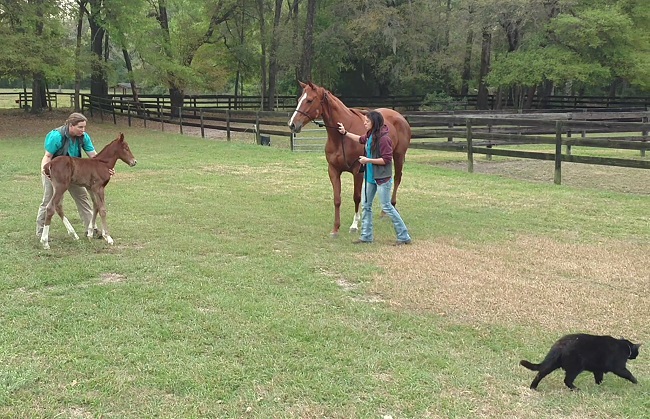Last weekend we had a professional animal trainer, Carolyn Rice, come to the clinic to help us work with a pig who is here for boarding. Carolyn has experience working with all types of animals, from zebras to camels, even ducks! While every animal is different in terms of how their brain works, any animal has the potential to learn. I’ve even managed to teach Teanie a trick or two. So, from one of those animals who is notoriously difficult to train, here are some tips on where to start with your unruly horse, pig, dog, cat, chicken, or other beloved pet.
Know your animal
Regardless of which species you are working with, you need to have a basic understanding of how their brain works before you can teach them anything.
Since this is an equine clinic, we will talk about horses first. Horses are prey animals, and as such, their fight-or-flight instinct is quite strong. This means that most horses will respond to you simply moving into their space, raising your arms to head-level, or driving them forward with your body position. Many horses are also food motivated, and will do just about anything for a small treat.
In a herd, all of the other horses will look to the dominant stallion to know whether or not something is a threat. Similarly, whether you are training on the ground or under saddle, your horse should look to you as the leader. If you say it’s okay, they need to trust you that there’s nothing to worry about.
As a prey species, horses have a point of balance, a pressure zone, and a flight zone. When a human, or other predator, stands in the horse’s flight zone, the horse will move away from the predator. The more tame a horse, the smaller its flight zone. This knowledge can be useful when trying to catch a horse in the field, moving a group of horses, or teaching a horse to work on a longe line.
Dogs, on the other hand, are predators who have been bred for centuries to be loyal to humans, almost to a fault. Dogs have a strong play drive, and love to be close to their people. Rather than flee away, most dogs will go toward a human who is running. If you’ve ever played fetch or tug-of-war with a dog, you know they love the thrill of winning.
Different species, and even different breeds, have a different assortment of talents. Dogs use their mouths to solve problems, whereas pigs use their snouts. If horses are faced with a problem, they will normally use their long legs and enormous lungs to run away quickly!
So, do some research on the animal you are working with. What is their history? What are they bred to be good at? How big is their brain? How well can they see, or smell? Can they learn words? Once you truly understand your pet, training will be a breeze.
Command respect
One of the best places to start in training your pet is with basic obedience, or ground manners. Respecting personal space is an important lesson for any young animal to learn. In the wild, other animals in a pack or a herd will teach personal space by biting, kicking, barking, or squealing when another animal gets too close. In a domestic setting, however, it is your job as the owner to teach your pet these ground rules.
Animals can actually push the boundaries of respect without you even realizing what they are doing. Does your horse ever use you as a scratching post? Does your dog put his paw on your leg when he wants attention? Does your pig root at your shoe when he wants to be fed? These are all actually subtle acts of defiance and insubordination which, over time, can make your pet believe that he or she is in charge.
An easy place to begin in terms of commanding respect is at feeding time. Pets depend on humans to provide for their basic needs, including food, water, and shelter. Every day at feeding time is an opportunity for you to work on that respect. For example, you can teach your dog or pig to sit and wait before you give him his food bowl. You can teach your horse or donkey to let you put their halter on before you dump their grain in their bucket. Working on these simple skills for just 5-10 minutes twice a day will go a long way.
Use positive reinforcement
In animal behavior, there are four types of reinforcement/punishment. There is positive reinforcement- for example when I get a piece of lunch meat for raising my paw. Negative reinforcement occurs when I walk outside to avoid the screaming pig in the barn (as soon as I step outside, the negative stimulus stops, which encourages me to go outside). I experience positive punishment whenever one of the techs swats me off the hood of the truck for scratching the paint and getting muddy footprints everywhere. Negative punishment happens when I am getting scritches from a client in the office, but they stop when I bite their hand.
My favorite of these options is positive reinforcement. I learn best and fastest when I am rewarded for performing a desired behavior. This is true for most animals, regardless of breed, species, or what behavior you are trying to teach. If you can figure out a way to use positive reinforcement in your training, you will be impressed with the results.
Here at Springhill Equine, the docs and techs also like to use clicker training as a form of positive reinforcement. Clickers can be used on any animals, even humans, to train a desired behavior. Too bad I don’t have opposable thumbs!
I hope these training tips have given you a starting point towards making your pet the productive member of society he was meant to be. If you ever have any questions about animal behavior, or need recommendations for a trainer, the humans at my office are always a great resource.
Sit. Stay. Good human. Now, scroll down and subscribe to this blog. Click!
-Tony


